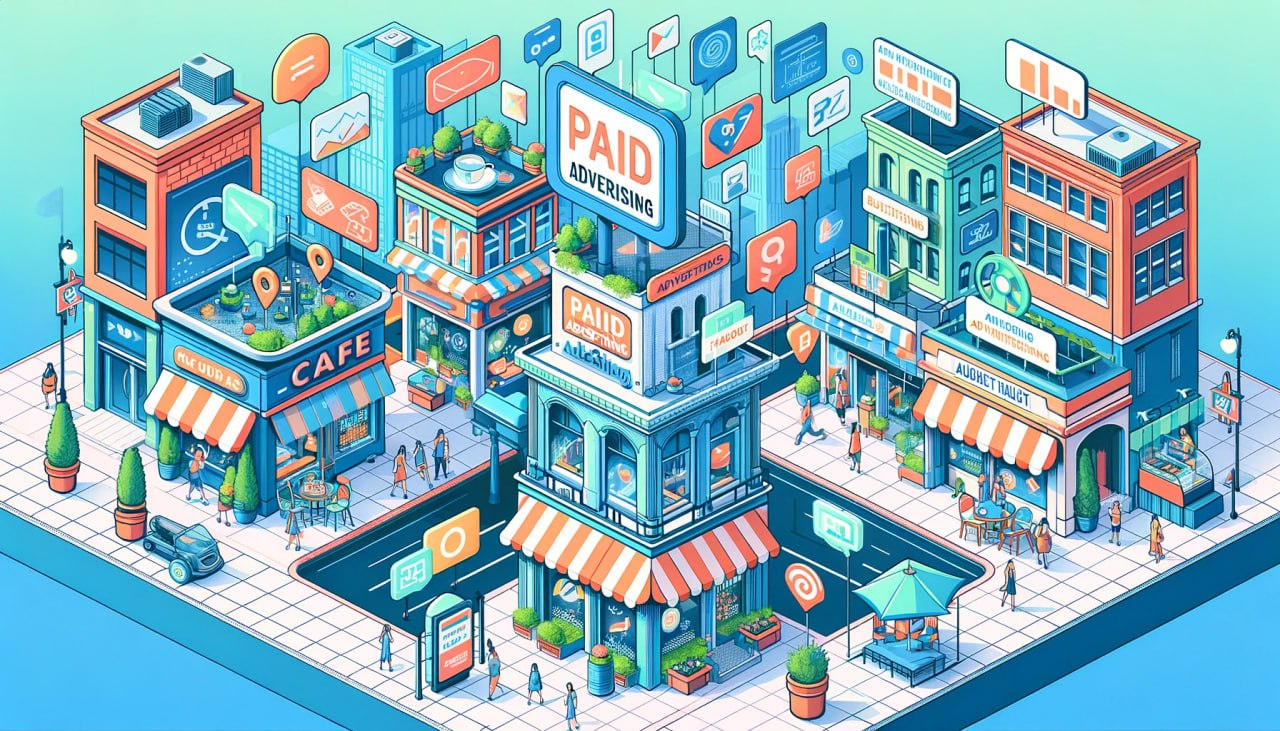
User Review
( votes)In the dynamic world of small business, where visibility is key to success, paid advertising stands as a beacon of opportunity. This introduction serves as a compass, guiding small business owners through the significance of strategic advertising in a digital landscape. As we embark on this journey, we’ll unravel the top 5 paid ads that hold the potential to transform your business trajectory. Let’s explore how these advertising avenues can propel your small business to new heights and open doors to unparalleled success.
Small businesses often find themselves facing a daunting challenge – breaking through the noise and reaching a broader audience in the competitive digital landscape. In this section, we delve into the unique hurdles encountered by small enterprises, from limited visibility to the struggle for audience attention. However, amidst these challenges lies the untapped potential of strategic paid advertising. We’ll explore how leveraging paid ads can be a game-changer, offering small businesses the opportunity to amplify their reach, connect with their target audience, and ultimately triumph over the hurdles that once seemed insurmountable. Get ready to unlock the power of paid advertising and witness your small business flourish.
Facebook Ads: Your Social Media Powerhouse

Facebook’s extensive user base and robust targeting capabilities make it a cornerstone for effective digital advertising. With over 2.8 billion monthly active users worldwide, Facebook provides an unparalleled reach for businesses aiming to connect with diverse audiences. This vast user base spans various demographics, interests, and geographic locations, offering a rich tapestry for advertisers to explore.
Facebook’s targeting capabilities are a standout feature, allowing advertisers to tailor their campaigns with remarkable precision. Businesses can define their audience based on demographics, such as age, gender, location, and interests. Moreover, Facebook’s advanced targeting options enable advertisers to reach specific groups, ensuring that their ads resonate with the most relevant audience segments.
The platform’s detailed targeting doesn’t stop there; it extends to behaviors, connections, and even custom audiences. Advertisers can engage users based on their online activities, purchase behaviors, and interactions with the brand. Additionally, custom audiences empower businesses to target individuals who have already shown interest, whether through website visits or engagement with previous ads.
Key Features of Facebook Ads:
Precise Targeting:
Facebook Ads allow small businesses to target specific demographics, interests, behaviors, and even custom audiences, ensuring that ads reach the most relevant potential customers.
Diverse Ad Formats:
Facebook offers a variety of ad formats, including image ads, video ads, carousel ads, and more. This diversity allows small businesses to choose the format that best suits their message and goals.
Engaging Visual Content:
The visually-oriented nature of Facebook makes it ideal for showcasing products and services through high-quality images and videos, capturing the attention of users in their news feeds.
Ad Placement Options:
Businesses can choose where their ads appear, whether in users’ news feeds, on Instagram, in the right column, or within the Audience Network. This flexibility ensures optimal visibility for the target audience.
Budget Control:
Small businesses can set daily or lifetime budgets, giving them full control over their advertising spend. This feature is particularly beneficial for businesses with limited budgets.
Ad Analytics and Insights:
Facebook provides robust analytics and insights into ad performance. Small businesses can track metrics such as reach, engagement, and conversions, enabling data-driven decisions to optimize future campaigns.
Benefits of Using Facebook Ads for Small Businesses:
Affordability:
Facebook Ads can be cost-effective, allowing small businesses with limited budgets to compete with larger counterparts. The platform’s flexible pricing options accommodate various financial constraints.
Increased Visibility:
Leveraging Facebook’s extensive user base ensures increased visibility for small businesses. Ads can reach a wide audience, helping to build brand awareness and attract potential customers.
Targeted Reach:
Precise targeting options enable small businesses to reach specific demographics most likely to be interested in their products or services, improving the efficiency of their advertising efforts.
Brand Engagement:
Visual and engaging ad formats facilitate increased brand engagement. Users are more likely to interact with content that resonates visually, fostering a stronger connection between businesses and their audiences.
Easy Campaign Management:
Facebook’s user-friendly Ads Manager makes it easy for small businesses to create, monitor, and adjust their ad campaigns. The platform provides a straightforward interface for campaign management.
Conversion Tracking:
Businesses can track the performance of their ads in terms of conversions, allowing them to measure the success of their campaigns and make data-driven adjustments for better results.
Google Ads: Mastering Search Engine Visibility
Google Ads, formerly known as Google AdWords, operates on a pay-per-click (PPC) model. Advertisers bid on specific keywords relevant to their products or services. When users enter these keywords into the Google search bar, a real-time auction takes place, determining which ads will be displayed. The winning ads are showcased prominently on the search engine results page (SERP) when users query those keywords.
Targeted Keyword Advertising:
Google Ads enable businesses to bid on keywords relevant to their offerings. This ensures that their ads appear when users actively search for products or services related to those keywords, increasing the likelihood of reaching a motivated audience.
Immediate Visibility:
Unlike organic search engine optimization (SEO), Google Ads provide businesses with immediate visibility. Advertisers can secure a prime position on the SERP for chosen keywords, ensuring their presence is seen by users searching for related information.
Customizable Ad Formats:
Google Ads offers diverse ad formats, including text ads, display ads, and video ads. This flexibility allows businesses to tailor their ad content to suit their marketing objectives, whether it’s driving website traffic, generating leads, or promoting specific products.
Geotargeting and Audience Segmentation:
Advertisers can refine their targeting with precision. Google Ads allow geotargeting, ensuring that ads are shown to users in specific locations. Additionally, audience segmentation based on demographics, interests, and online behavior further enhances targeting capabilities.
Budget Control and ROI Tracking:
Businesses have control over their advertising budget, setting daily or lifetime limits. This ensures that advertising spending aligns with financial objectives. Moreover, Google Ads provides robust analytics, allowing advertisers to track the return on investment (ROI) and adjust strategies accordingly.
Ad Extensions for Enhanced Information:
Advertisers can use ad extensions to provide additional information, such as location details, contact information, or links to specific pages. This enhances the visibility of key business information and encourages user interaction.
Instagram Ads: Visual Storytelling for Business Growth

Instagram, a platform renowned for its emphasis on visuals, provides an immersive experience for users. Instagram Ads seamlessly blend into users’ feeds, delivering a visually appealing and native feel that enhances engagement. Key features of Instagram ads:
High-Quality Imagery and Video Content:
Businesses can leverage high-quality imagery and video content to showcase products, services, and brand narratives. Instagram Ads support visually stunning content, allowing small businesses to tell their story in a compelling and visually striking manner.
Story and Carousel Ads for Narratives:
Instagram offers unique ad formats like Stories and Carousels that enable businesses to craft narratives. Stories Ads appear in a slideshow format, perfect for brief yet impactful storytelling. Carousels allow businesses to showcase multiple images or videos in a single ad, providing a narrative sequence.
Interactive Elements with Polls and Swipe-Ups:
Instagram Ads can incorporate interactive elements, such as polls in Stories or swipe-up links for direct actions. These features encourage user engagement and participation, fostering a sense of connection between businesses and their audience.
Creative Ways for Small Businesses:
Behind-the-Scenes Glimpses:
Small businesses can use Instagram Ads to offer behind-the-scenes glimpses of their operations, products, or team. This authentic approach humanizes the brand, creating a connection with followers.
User-Generated Content Campaigns:
Encouraging customers to create content through contests or hashtags and then showcasing this user-generated content in Instagram Ads fosters community engagement and authentic brand advocacy.
Product Showcases and Demonstrations:
Businesses can use Instagram Ads to showcase products or services in action. This can include product demonstrations, tutorials, or highlighting unique features to educate and entice potential customers.
Limited-Time Offers and Flash Sales:
Creating a sense of urgency through limited-time offers or flash sales in Instagram Ads can drive immediate action from users. This strategy taps into the platform’s real-time nature.
Influencer Collaborations:
Small businesses can collaborate with influencers relevant to their niche for sponsored content. Influencer partnerships on Instagram can significantly amplify reach and credibility.
LinkedIn Ads: B2B Success and Professional Networking

LinkedIn boasts a user base primarily composed of professionals, executives, and decision-makers across various industries. This audience is actively engaged in professional development, making it an ideal platform for B2B interactions.
Industry-specific Networking:
LinkedIn serves as a virtual hub for industry-specific networking. Professionals use the platform to connect with peers, stay updated on industry trends, and explore business opportunities, creating a fertile ground for B2B marketing.
Decision-Making Authority:
Unlike other social platforms, LinkedIn users often hold decision-making roles within their organizations. This positions LinkedIn Ads to directly reach individuals with the authority to make purchasing decisions, making it a strategic channel for B2B campaigns.
Targeting Strategies for B2B Marketing through LinkedIn Ads
Job Title Targeting:
LinkedIn Ads allow businesses to target users based on their job titles. This precise targeting ensures that ads are delivered to professionals holding specific roles relevant to the product or service being promoted.
Company Size and Industry Targeting:
B2B marketers can refine their audience based on company size and industry. This targeting strategy ensures that ads reach businesses of a certain scale and operate within specific sectors, aligning with the target market.
LinkedIn Groups and Interests:
Leveraging LinkedIn Groups and user interests provides an avenue to target professionals based on their affiliations and preferences. Businesses can align their ads with groups or topics that resonate with their B2B offerings.
Sponsored Content for Thought Leadership:
Sponsored content on LinkedIn allows businesses to share thought leadership content directly in users’ feeds. This can include whitepapers, case studies, and industry insights, establishing the brand as an authority in the B2B space.
In-Mail Campaigns for Direct Outreach:
LinkedIn Ads offers InMail campaigns, enabling businesses to send personalized messages directly to targeted professionals. This direct outreach can be tailored for lead generation, event invitations, or product launches.
Dynamic Ads for Personalization:
Dynamic Ads on LinkedIn allow for personalized content based on users’ profiles. B2B marketers can use this feature to create customized experiences, increasing relevance and engagement.
Local Advertising: Targeting Your Community Effectively
Local advertising emerges as a powerful tool for small businesses, creating a bridge between the brand and its immediate community. While fostering a strong connection with the community, it allows businesses to become an integral part of the neighborhood, building trust and loyalty among local residents.
Increased Visibility:
Small businesses can enhance their visibility within their immediate area through local advertising. This is particularly crucial for businesses that rely on local foot traffic or serve a specific geographic region.
Targeting Relevant Audience:
Local advertising enables businesses to target an audience that is geographically aligned with their operations. This ensures that promotional efforts are directed toward individuals likely to engage with the business locally.
Supporting Local Economy:
By investing in local advertising, businesses contribute to the growth of the local economy. This reciprocal relationship fosters a sense of community support, encouraging residents to choose local businesses over larger, non-local competitors.
Platforms and Strategies for Hyper-Local Advertising
Google My Business:
Utilizing Google My Business allows businesses to create a local business profile that appears in Google Search and Maps. This platform is essential for providing accurate information, such as location, hours, and customer reviews.
Local SEO Optimization:
Implementing local SEO strategies ensures that businesses appear in local search results. This includes optimizing website content with local keywords, obtaining local backlinks, and managing online reviews.
Social Media Geotargeting:
Social media platforms, such as Facebook and Instagram, offer geotargeting options for advertising. Businesses can create targeted ads that specifically reach users within a defined geographic radius, maximizing local impact.
Community Events and Sponsorships:
Actively participating in or sponsoring local events builds brand visibility and community engagement. This can include supporting sports teams, local festivals, or charitable initiatives.
Local Print Media:
Advertising in local newspapers, community newsletters, or magazines provides a tangible and localized way to reach the target audience. Print media is particularly effective for businesses targeting specific neighborhoods.
Collaborations with Local Influencers:
Partnering with local influencers or community leaders can amplify the reach of local advertising efforts. Influencers can authentically promote businesses to their local following.
Targeted Direct Mail Campaigns:
Direct mail, such as postcards or flyers, can be tailored for hyper-local advertising. This approach ensures that physical promotional materials reach specific households in the immediate vicinity.
As we conclude this journey through the top 5 paid ads, small business owners now possess a powerful arsenal to redefine their trajectories and achieve unprecedented success. From the expansive reach and precision targeting of Facebook Ads to the immediate visibility and customizable formats of Google Ads, the visual storytelling prowess of Instagram Ads, the professional networking avenues of LinkedIn Ads, and the community-centric impact of Local Advertising – each platform offers a unique set of tools to overcome the challenges faced by small enterprises.







